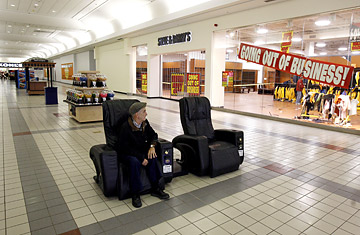
A quiet shopping mall in Danvers, Mass.
(2 of 2)
Office Depot
In December, Office Depot announced that it would close 9% of its North American stores, giving it 1,163 locations. The company will shut another 14 stores in 2009, while closing six of its 33 North American distribution facilities. Staples is now the dominant office supply brand. "Though Office Depot's situation is less dire than Pier 1 Imports, they are certainly on the ropes as well," says Chukumba. Office Depot's less capital-intensive contract business — which involves making deals with companies and governments to supply them with paper, pens and staplers — somewhat shields it from the more dire retail shocks. But the company is still in a dangerous spot. "With their leases and off-balance-sheet leverage, Office Depot's financial risk is undoubtedly high," says Stephen Chick, an equity analyst at Friedman, Billings, Ramsey & Co.
Chukumba suggests that Office Depot merge with competitor Office Max in order to bulk up for the battle against Staples. He believes cost-cutting has hurt service, a problem that should never be dismissed. (For example, poor service contributed to Circuit City's demise). "Every time I go into an Office Depot," says Chukumba, "I see out-of-stock merchandise. To me, that indicates you don't have enough people."
The company reported a net loss of $7 million in the third quarter of 2008, compared with earnings of $117 million in the same period in 2007. Still, the company insists that its liquidity remains intact. "We ended the third quarter with $395 million in cash and cash equivalents," says Office Depot spokesman Brian Levine. "While the fourth quarter is not yet closed, we believe that we did not burn cash. It is our intent that we will maintain our liquidity throughout 2009, even under our most conservative projections of the economic environment."
Jamba Juice
It's not a great time to sell discretionary items. It's an even worse time to sell very discretionary items. Do you really need that fruit smoothie? Apparently not: Jamba Juice, the fruit-drink chain, lost $108 million in the first 40 weeks of 2008, compared with a $36.7 million profit during the same period in 2007. Same-store sales dipped 7.2%. In December, Jamba stopped shipping ready-to-drink smoothies to grocery stores because of production difficulties. "They still don't know who their core customer is," says Brian Moore, an analyst at Wedbush Morgan. "They have to define that. Is it the health-conscious consumer or someone who is looking for a treat? That's why the brand has had difficulty." Responds new CEO James White, an ex-Safeway executive who took over Jamba eight weeks ago: "From a historical perspective, that may be exactly right. But the current management team on the field, with its deep CPG [consumer products goods] experience, knows how to do this work. We've worked on the best brands on the planet. We're very confident we know what to do to turn around the company." White scoffs at talk that Jamba is on the ropes. (See the top 10 food trends of 2008.)
Location doesn't help the company. Most of Jamba's 749 stores are in California, where the housing market is particularly harsh and where unemployment is at a 15-year high. Jamba announced plans to cut $25 million in costs for 2009, while opening 50 franchise outlets at colleges, airports and malls. To spark sales, the company has introduced oatmeal to its breakfast menu. Can that lift a struggling chain? Unfortunately, you probably shouldn't bet on it. These days, who has enough money for oatmeal?
